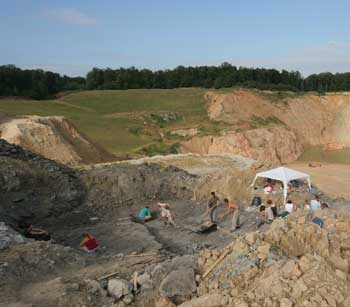| Location: Home > News > Events |
| Scientific American: Small Triceratops relative suggests new dinosaur migration routes from Asia to Europe |
|
Some 100 million to 65 million years ago, when Europe was an island archipelago, a small horned dinosaur roamed what is now Hungary. Fossil remains from this tiny dinosaur represent the first ceratopsian found in Europe and shed new light on the distribution and movement of dinosaurs during that period. It is described online May 26 in Nature (Scientific American is part of Nature Publishing Group).
 Excavation site in Hungary (courtesy of Gábor Czirják)
The new dinosaur "provides information that will require re-evaluation of our biogeographical understanding of the Late Cretaceous fauna of Europe," Xing Xu, of the Key Laboratory of Evolutionary Systematics of Vertebrates at the Institute of Vertebrate Paleontology and Paleoanthropology in Beijing, wrote in an accompanying essay also published in Nature.
The animals living in Europe during the Cretaceous period were thought to be isolated descendants of those stranded there for millions of years because there were few known examples of crossover with North American or Asian species. The appearance of a ceratopsian dino now changes all of that, revealing close links to other species that have been found around the same period in Asia. The new dinosaur, Ajkaceratops kozmai, has been evaluated from just three skull bones, but they show "clear diagnostic features of horned dinosaurs" and obvious ties to coronosaurians, the same group to which Triceratops belongs, Xu noted. Ajkaceratops was likely just one meter long, making it about 12 percent the size of a towering Triceratops. The diminutive stature is not surprising, however, as many animals—including other European dinosaurs from this period—living in island environments have been shown to shrink over time, a phenomenon known as island dwarfing. Other hints of horned dinosaurs have turned up recently in Europe. In particular, teeth suspected to be from a Leptoceratops were recently found in Sweden. But A. kozmai provides the strongest piece of evidence for a Late Cretaceous Asia-to-Europe move. Although the authors, led by Attila Osi, of the Hungarian Academy of Sciences, hypothesized that the discovery of Ajkaceratops and the Leptoceratops teeth in northern Europe indicate two separate migrations of horned dinosaurs from Asia into Europe, Xu remained cautious, noting that as of yet, it "cannot be described as a firm conclusion." More fossil finds will be necessary before a clearer map of Cretaceous period dinosaur migration into Europe can be painted. But "the discovery of Ajkaceratops may mark the beginning of a better understanding of the Late Cretaceous fauna of Europe," Xu noted, "and ultimately of the Late Cretaceous biogeography of the planet as a whole." |